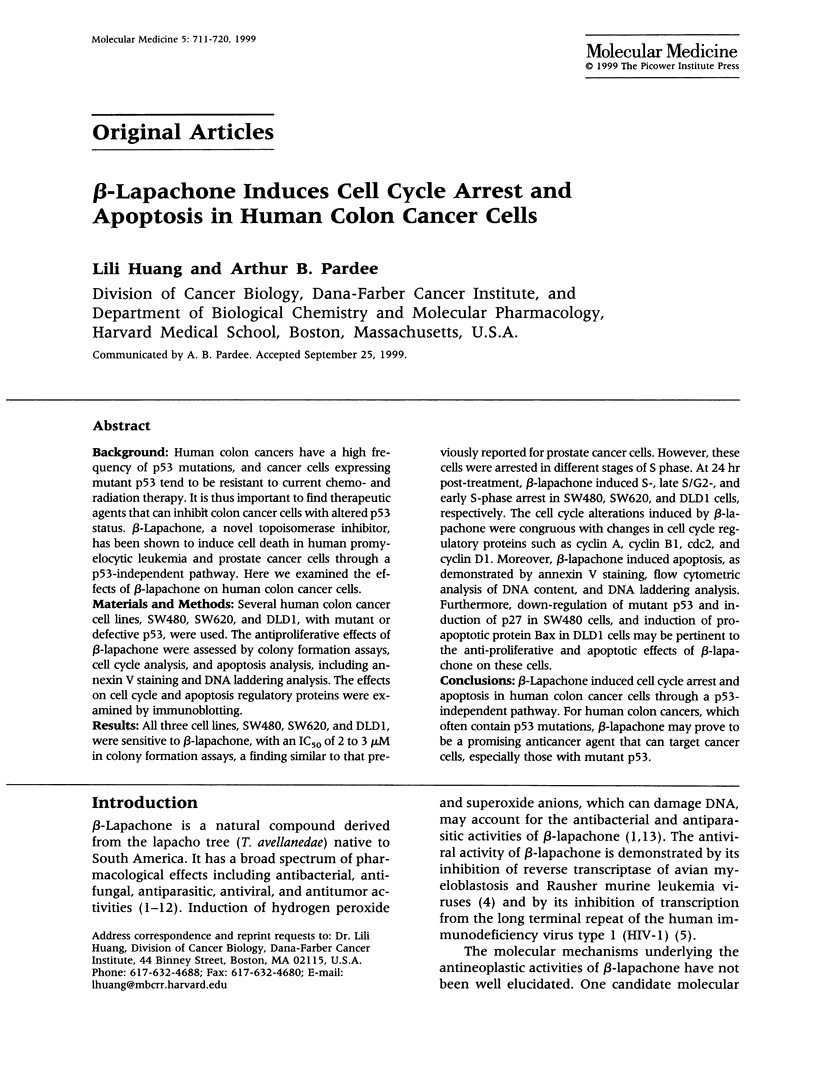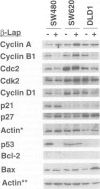Abstract
BACKGROUND: Human colon cancers have a high frequency of p53 mutations, and cancer cells expressing mutant p53 tend to be resistant to current chemo- and radiation therapy. It is thus important to find therapeutic agents that can inhibit colon cancer cells with altered p53 status. beta-Lapachone, a novel topoisomerase inhibitor, has been shown to induce cell death in human promyelocytic leukemia and prostate cancer cells through a p53-independent pathway. Here we examined the effects of beta-lapachone on human colon cancer cells. MATERIALS AND METHODS: Several human colon cancer cell lines, SW480, SW620, and DLD1, with mutant or defective p53, were used. The antiproliferative effects of beta-lapachone were assessed by colony formation assays, cell cycle analysis, and apoptosis analysis, including annexin V staining and DNA laddering analysis. The effects on cell cycle and apoptosis regulatory proteins were examined by immunoblotting. RESULTS: All three cell lines, SW480, SW620, and DLD1, were sensitive to beta-lapachone, with an IC(50) of 2 to 3 microM in colony formation assays, a finding similar to that previously reported for prostate cancer cells. However, these cells were arrested in different stages of S phase. At 24 hr post-treatment, beta-lapachone induced S-, late S/G2-, and early S-phase arrest in SW480, SW620, and DLD1 cells, respectively. The cell cycle alterations induced by beta-lapachone were congruous with changes in cell cycle regulatory proteins such as cyclin A, cyclin B1, cdc2, and cyclin D1. Moreover, beta-lapachone induced apoptosis, as demonstrated by annexin V staining, flow cytometric analysis of DNA content, and DNA laddering analysis. Furthermore, down-regulation of mutant p53 and induction of p27 in SW480 cells, and induction of pro-apoptotic protein Bax in DLD1 cells may be pertinent to the anti-proliferative and apoptotic effects of beta-lapachone on these cells. CONCLUSIONS: beta-Lapachone induced cell cycle arrest and apoptosis in human colon cancer cells through a p53-independent pathway. For human colon cancers, which often contain p53 mutations, beta-lapachone may prove to be a promising anticancer agent that can target cancer cells, especially those with mutant p53.
Full text
PDF









Images in this article
Selected References
These references are in PubMed. This may not be the complete list of references from this article.
- Ahmad N., Feyes D. K., Agarwal R., Mukhtar H. Photodynamic therapy results in induction of WAF1/CIP1/P21 leading to cell cycle arrest and apoptosis. Proc Natl Acad Sci U S A. 1998 Jun 9;95(12):6977–6982. doi: 10.1073/pnas.95.12.6977. [DOI] [PMC free article] [PubMed] [Google Scholar]
- Bates S., Vousden K. H. p53 in signaling checkpoint arrest or apoptosis. Curr Opin Genet Dev. 1996 Feb;6(1):12–18. doi: 10.1016/s0959-437x(96)90004-0. [DOI] [PubMed] [Google Scholar]
- Boorstein R. J., Pardee A. B. Beta-lapachone greatly enhances MMS lethality to human fibroblasts. Biochem Biophys Res Commun. 1984 Feb 14;118(3):828–834. doi: 10.1016/0006-291x(84)91469-4. [DOI] [PubMed] [Google Scholar]
- Boothman D. A., Greer S., Pardee A. B. Potentiation of halogenated pyrimidine radiosensitizers in human carcinoma cells by beta-lapachone (3,4-dihydro-2,2-dimethyl-2H-naphtho[1,2-b]pyran- 5,6-dione), a novel DNA repair inhibitor. Cancer Res. 1987 Oct 15;47(20):5361–5366. [PubMed] [Google Scholar]
- Boothman D. A., Trask D. K., Pardee A. B. Inhibition of potentially lethal DNA damage repair in human tumor cells by beta-lapachone, an activator of topoisomerase I. Cancer Res. 1989 Feb 1;49(3):605–612. [PubMed] [Google Scholar]
- Cho K. R., Vogelstein B. Suppressor gene alterations in the colorectal adenoma-carcinoma sequence. J Cell Biochem Suppl. 1992;16G:137–141. doi: 10.1002/jcb.240501124. [DOI] [PubMed] [Google Scholar]
- Cruz F. S., Docampo R., Boveris A. Generation of superoxide anions and hydrogen peroxide from beta-lapachone in bacteria. Antimicrob Agents Chemother. 1978 Oct;14(4):630–633. doi: 10.1128/aac.14.4.630. [DOI] [PMC free article] [PubMed] [Google Scholar]
- Degrassi F., De Salvia R., Berghella L. The production of chromosomal alterations by beta-lapachone, an activator of topoisomerase I. Mutat Res. 1993 Aug;288(2):263–267. doi: 10.1016/0027-5107(93)90093-u. [DOI] [PubMed] [Google Scholar]
- Dignam J. D., Lebovitz R. M., Roeder R. G. Accurate transcription initiation by RNA polymerase II in a soluble extract from isolated mammalian nuclei. Nucleic Acids Res. 1983 Mar 11;11(5):1475–1489. doi: 10.1093/nar/11.5.1475. [DOI] [PMC free article] [PubMed] [Google Scholar]
- Dittmer D., Pati S., Zambetti G., Chu S., Teresky A. K., Moore M., Finlay C., Levine A. J. Gain of function mutations in p53. Nat Genet. 1993 May;4(1):42–46. doi: 10.1038/ng0593-42. [DOI] [PubMed] [Google Scholar]
- Frydman B., Marton L. J., Sun J. S., Neder K., Witiak D. T., Liu A. A., Wang H. M., Mao Y., Wu H. Y., Sanders M. M. Induction of DNA topoisomerase II-mediated DNA cleavage by beta-lapachone and related naphthoquinones. Cancer Res. 1997 Feb 15;57(4):620–627. [PubMed] [Google Scholar]
- Guiraud P., Steiman R., Campos-Takaki G. M., Seigle-Murandi F., Simeon de Buochberg M. Comparison of antibacterial and antifungal activities of lapachol and beta-lapachone. Planta Med. 1994 Aug;60(4):373–374. doi: 10.1055/s-2006-959504. [DOI] [PubMed] [Google Scholar]
- Hsiang Y. H., Hertzberg R., Hecht S., Liu L. F. Camptothecin induces protein-linked DNA breaks via mammalian DNA topoisomerase I. J Biol Chem. 1985 Nov 25;260(27):14873–14878. [PubMed] [Google Scholar]
- Katayose Y., Kim M., Rakkar A. N., Li Z., Cowan K. H., Seth P. Promoting apoptosis: a novel activity associated with the cyclin-dependent kinase inhibitor p27. Cancer Res. 1997 Dec 15;57(24):5441–5445. [PubMed] [Google Scholar]
- Korsmeyer S. J. Regulators of cell death. Trends Genet. 1995 Mar;11(3):101–105. doi: 10.1016/S0168-9525(00)89010-1. [DOI] [PubMed] [Google Scholar]
- Lai C. C., Liu T. J., Ho L. K., Don M. J., Chau Y. P. beta-Lapachone induced cell death in human hepatoma (HepA2) cells. Histol Histopathol. 1998 Jan;13(1):89–97. doi: 10.14670/HH-13.89. [DOI] [PubMed] [Google Scholar]
- Li C. J., Averboukh L., Pardee A. B. beta-Lapachone, a novel DNA topoisomerase I inhibitor with a mode of action different from camptothecin. J Biol Chem. 1993 Oct 25;268(30):22463–22468. [PubMed] [Google Scholar]
- Li C. J., Li Y. Z., Pinto A. V., Pardee A. B. Potent inhibition of tumor survival in vivo by beta-lapachone plus taxol: combining drugs imposes different artificial checkpoints. Proc Natl Acad Sci U S A. 1999 Nov 9;96(23):13369–13374. doi: 10.1073/pnas.96.23.13369. [DOI] [PMC free article] [PubMed] [Google Scholar]
- Li C. J., Wang C., Pardee A. B. Induction of apoptosis by beta-lapachone in human prostate cancer cells. Cancer Res. 1995 Sep 1;55(17):3712–3715. [PubMed] [Google Scholar]
- Li C. J., Zhang L. J., Dezube B. J., Crumpacker C. S., Pardee A. B. Three inhibitors of type 1 human immunodeficiency virus long terminal repeat-directed gene expression and virus replication. Proc Natl Acad Sci U S A. 1993 Mar 1;90(5):1839–1842. doi: 10.1073/pnas.90.5.1839. [DOI] [PMC free article] [PubMed] [Google Scholar]
- Li Y. Z., Li C. J., Pinto A. V., Pardee A. B. Release of mitochondrial cytochrome C in both apoptosis and necrosis induced by beta-lapachone in human carcinoma cells. Mol Med. 1999 Apr;5(4):232–239. [PMC free article] [PubMed] [Google Scholar]
- Liu P. K., Kraus E., Wu T. A., Strong L. C., Tainsky M. A. Analysis of genomic instability in Li-Fraumeni fibroblasts with germline p53 mutations. Oncogene. 1996 Jun 6;12(11):2267–2278. [PMC free article] [PubMed] [Google Scholar]
- Lowe S. W., Bodis S., McClatchey A., Remington L., Ruley H. E., Fisher D. E., Housman D. E., Jacks T. p53 status and the efficacy of cancer therapy in vivo. Science. 1994 Nov 4;266(5186):807–810. doi: 10.1126/science.7973635. [DOI] [PubMed] [Google Scholar]
- Lowe S. W. Cancer therapy and p53. Curr Opin Oncol. 1995 Nov;7(6):547–553. doi: 10.1097/00001622-199511000-00013. [DOI] [PubMed] [Google Scholar]
- Martin S. J., Reutelingsperger C. P., McGahon A. J., Rader J. A., van Schie R. C., LaFace D. M., Green D. R. Early redistribution of plasma membrane phosphatidylserine is a general feature of apoptosis regardless of the initiating stimulus: inhibition by overexpression of Bcl-2 and Abl. J Exp Med. 1995 Nov 1;182(5):1545–1556. doi: 10.1084/jem.182.5.1545. [DOI] [PMC free article] [PubMed] [Google Scholar]
- O'Connor P. M., Jackman J., Bae I., Myers T. G., Fan S., Mutoh M., Scudiero D. A., Monks A., Sausville E. A., Weinstein J. N. Characterization of the p53 tumor suppressor pathway in cell lines of the National Cancer Institute anticancer drug screen and correlations with the growth-inhibitory potency of 123 anticancer agents. Cancer Res. 1997 Oct 1;57(19):4285–4300. [PubMed] [Google Scholar]
- Pagano M., Theodoras A. M., Tam S. W., Draetta G. F. Cyclin D1-mediated inhibition of repair and replicative DNA synthesis in human fibroblasts. Genes Dev. 1994 Jul 15;8(14):1627–1639. doi: 10.1101/gad.8.14.1627. [DOI] [PubMed] [Google Scholar]
- Planchon S. M., Wuerzberger S., Frydman B., Witiak D. T., Hutson P., Church D. R., Wilding G., Boothman D. A. Beta-lapachone-mediated apoptosis in human promyelocytic leukemia (HL-60) and human prostate cancer cells: a p53-independent response. Cancer Res. 1995 Sep 1;55(17):3706–3711. [PMC free article] [PubMed] [Google Scholar]
- Pommier Y. Diversity of DNA topoisomerases I and inhibitors. Biochimie. 1998 Mar;80(3):255–270. doi: 10.1016/s0300-9084(98)80008-4. [DOI] [PubMed] [Google Scholar]
- Schuerch A. R., Wehrli W. beta-Lapachone, an inhibitor of oncornavirus reverse transcriptase and eukaryotic DNA polymerase-alpha. Inhibitory effect, thiol dependence and specificity. Eur J Biochem. 1978 Mar;84(1):197–205. doi: 10.1111/j.1432-1033.1978.tb12157.x. [DOI] [PubMed] [Google Scholar]
- Sheikh M. S., Chen Y. Q., Smith M. L., Fornace A. J., Jr Role of p21Waf1/Cip1/Sdi1 in cell death and DNA repair as studied using a tetracycline-inducible system in p53-deficient cells. Oncogene. 1997 Apr 17;14(15):1875–1882. doi: 10.1038/sj.onc.1201004. [DOI] [PubMed] [Google Scholar]
- Sinicrope F. A., Roddey G., Lemoine M., Ruan S., Stephens L. C., Frazier M. L., Shen Y., Zhang W. Loss of p21WAF1/Cip1 protein expression accompanies progression of sporadic colorectal neoplasms but not hereditary nonpolyposis colorectal cancers. Clin Cancer Res. 1998 May;4(5):1251–1261. [PubMed] [Google Scholar]
- Vanni A., Fiore M., De Salvia R., Cundari E., Ricordy R., Ceccarelli R., Degrassi F. DNA damage and cytotoxicity induced by beta-lapachone: relation to poly(ADP-ribose) polymerase inhibition. Mutat Res. 1998 Jun 5;401(1-2):55–63. doi: 10.1016/s0027-5107(97)00273-x. [DOI] [PubMed] [Google Scholar]
- Wang J. C. DNA topoisomerases. Annu Rev Biochem. 1996;65:635–692. doi: 10.1146/annurev.bi.65.070196.003223. [DOI] [PubMed] [Google Scholar]
- Weller M., Winter S., Schmidt C., Esser P., Fontana A., Dichgans J., Groscurth P. Topoisomerase-I inhibitors for human malignant glioma: differential modulation of p53, p21, bax and bcl-2 expression and of CD95-mediated apoptosis by camptothecin and beta-lapachone. Int J Cancer. 1997 Nov 27;73(5):707–714. doi: 10.1002/(sici)1097-0215(19971127)73:5<707::aid-ijc16>3.0.co;2-2. [DOI] [PubMed] [Google Scholar]
- Wuerzberger S. M., Pink J. J., Planchon S. M., Byers K. L., Bornmann W. G., Boothman D. A. Induction of apoptosis in MCF-7:WS8 breast cancer cells by beta-lapachone. Cancer Res. 1998 May 1;58(9):1876–1885. [PubMed] [Google Scholar]
- Yang Z. Y., Perkins N. D., Ohno T., Nabel E. G., Nabel G. J. The p21 cyclin-dependent kinase inhibitor suppresses tumorigenicity in vivo. Nat Med. 1995 Oct;1(10):1052–1056. doi: 10.1038/nm1095-1052. [DOI] [PubMed] [Google Scholar]






